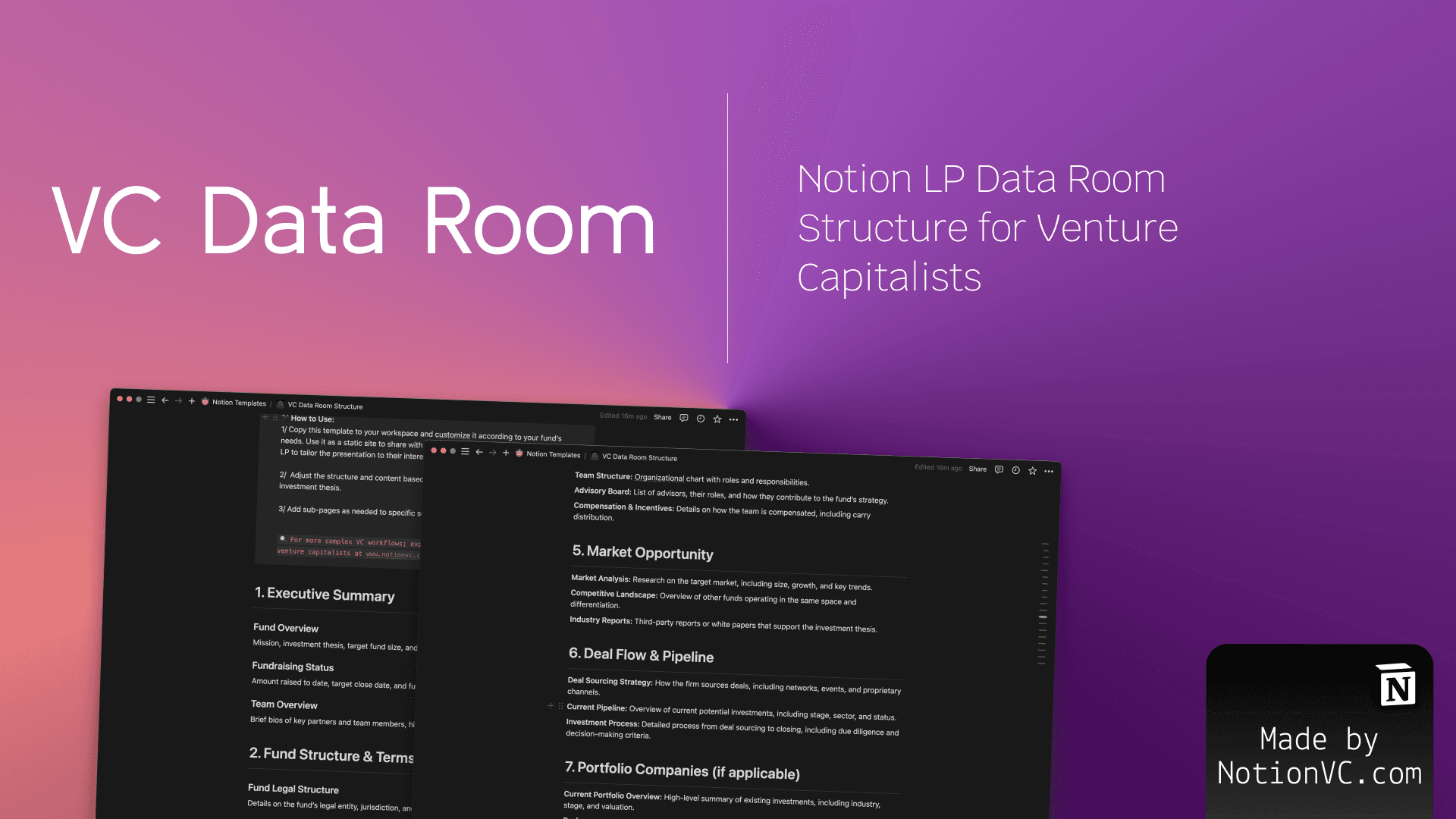🔥 Limited time discount! Use code "HEYFRIEND25" to get 25% OFF at checkout.
9 Aug 2024
In the world of venture capital, raising capital from Limited Partners (LPs) is a pivotal process that requires transparency, organization, and efficiency. One of the most critical tools in this process is the data room—a secure repository of documents that provides potential investors with all the information they need to make informed decisions. But what exactly should go into a VC data room, and why is it so important?
Why a Well-Structured Data Room Matters
A well-organized data room is more than just a collection of documents; it’s a reflection of your fund’s professionalism, transparency, and readiness. When LPs evaluate a venture capital fund, they are not just looking at past performance or the potential of your investment thesis—they are assessing the fund’s ability to operate effectively and responsibly. A comprehensive data room allows LPs to conduct thorough due diligence, minimizing risks and building trust.
Moreover, a well-structured data room can significantly speed up the fundraising process. Instead of repeatedly answering the same questions from different LPs, you can provide all the necessary information upfront, allowing potential investors to conduct their assessments independently. This not only saves time but also demonstrates that you have nothing to hide.
Tools for Building Your Data Room
Creating a data room doesn’t have to be a complicated or expensive process. There are numerous tools available, ranging from dedicated virtual data room (VDR) platforms to more general cloud-based solutions. Here are a few options:
1. Dedicated Virtual Data Room Platforms:
There are many apps available in the market, offering various features tailored to the needs of VC firms and their LPs. Here are some examples:
• Intralinks: A popular choice for secure document sharing and collaboration, Intralinks offers features like watermarking, permission controls, and audit trails.
• Firmex: Another VDR solution that provides secure document management, Firmex is known for its user-friendly interface and robust security features.
• Ansarada: Tailored specifically for deal management, Ansarada offers AI-powered insights, secure sharing, and document tracking.
2. General Cloud-Based Tools:
• Google Drive: While not as specialized as VDRs, Google Drive is a cost-effective and easy-to-use solution for storing and sharing documents. It offers collaboration features, permission controls, and integrates well with other Google Workspace tools.
• Dropbox: Similar to Google Drive, Dropbox is a widely-used tool that offers secure document storage and sharing, along with version control and easy accessibility.
• Notion: For those who prefer a more customizable and visually engaging platform, Notion allows you to create structured pages and databases, making it easier to present your information in a clear and organized manner.
Each of these tools has its strengths, and the right choice depends on your specific needs, such as the size of your fund, the number of documents, and your budget. Dedicated VDRs offer advanced security and compliance features that might be necessary for larger funds or more complex transactions, while cloud-based tools provide flexibility and ease of use that can be beneficial for smaller funds or early-stage VCs.
Tailoring Your Data Room to Your Fund
It’s important to note that the structure and granularity of your data room should reflect the positioning of your VC firm and the size of your fund. A seed-stage VC might not need the same level of detail as a large growth-stage fund. The key is to strike the right balance between providing enough information to satisfy LPs’ due diligence needs without overwhelming them with unnecessary details.
For example, smaller funds might choose to focus more on the unique aspects of their investment thesis and the strength of their team, while larger funds might need to provide more detailed financial statements, compliance documents, and portfolio performance metrics.
Get A Free VC Data Room Structure
Download here free of charge.

Example of a VC Data Room Structure
To give you a clearer idea, here’s a sample structure for a VC data room that balances comprehensiveness with clarity. Again, treat this as a longlist of items
1. Executive Summary
Fund Overview: Mission, investment thesis, target fund size, and target returns.
Fundraising Status: Amount raised to date, target close date, and fundraising milestones.
Team Overview: Brief bios of key partners and team members, highlighting relevant investment experience.
2. Fund Structure & Terms
Fund Legal Structure: Details on the fund’s legal entity, jurisdiction, and governance structure.
Term Sheet: Summary of key terms (e.g., management fees, carry, preferred returns, hurdle rates).
Subscription Documents: Templates for LP agreements, capital commitments, and side letters.
Previous Fund Performance: Track record and performance metrics of prior funds (if applicable).
3. Investment Strategy
Target Sectors & Geographies: Overview of industries, stages, and regions the fund will invest in.
Unique Investment Thesis: Highlight your unique market insight. Why does this fund need to exist?
Portfolio Construction: Expected number of investments, check sizes, and reserve strategy.
Value Creation Plan: How the VC adds value to portfolio companies (e.g., board involvement, operational support, network access).
4. Team & Advisors
Partner Bios: Detailed resumes of all partners, including past investment experience and exits.
Team Structure: Organizational chart with roles and responsibilities.
Advisory Board: List of advisors, their roles, and how they contribute to the fund’s strategy.
Compensation & Incentives: Details on how the team is compensated, including carry distribution.
5. Market Opportunity
Market Analysis: Research on the target market, including size, growth, and key trends.
Competitive Landscape: Overview of other funds operating in the same space and differentiation.
Industry Reports: Third-party reports or white papers that support the investment thesis.
6. Deal Flow & Pipeline
Deal Sourcing Strategy: How the firm sources deals, including networks, events, and proprietary channels.
Current Pipeline: Overview of current potential investments, including stage, sector, and status.
Investment Process: Detailed process from deal sourcing to closing, including due diligence and decision-making criteria.
7. Portfolio Companies (if applicable)
Current Portfolio Overview: High-level summary of existing investments, including industry, stage, and valuation.
Performance Metrics: Key performance indicators (KPIs) for each portfolio company.
Case Studies: In-depth analysis of select portfolio companies, showcasing value creation and exits.
Cap Table Information: Capitalization tables for portfolio companies, including current ownership percentages.
8. Financials
Fund Financials: Historical and projected financial statements, including cash flow, P&L, and balance sheets.
Capital Calls & Distributions: Schedule of past and projected capital calls, distributions, and return on investment (ROI).
Fee Structure: Detailed breakdown of management fees, carried interest, and other associated costs.
Audited Financials: Copies of any audited financial statements for prior funds or the current fund (if available).
9. Legal & Compliance
Legal Documents: Partnership agreements, subscription agreements, and other key legal documents.
Compliance Policies: Policies on conflicts of interest, anti-money laundering (AML), know your customer (KYC), etc.
Risk Management: Overview of risk management strategies and how risks are mitigated.
10. Communications & Reporting
Investor Communications Plan: How the firm plans to communicate with LPs (e.g., quarterly reports, annual meetings).
Reporting Templates: Examples of quarterly and annual reports.
Investor Portal: Information about any digital platform or portal used for investor communications.
11. Additional Resources
FAQs: Common questions from LPs and detailed answers.
Glossary: Definitions of key terms used throughout the documents.
Supporting Documents: Any additional documents that support the fund’s strategy or operations (e.g., media articles, interviews, etc.).
12. Closing & Contact Information
Next Steps: Clear instructions for LPs on how to proceed if interested, including timelines.
Contact Details: Key contacts for the fundraising process, including partners, IR team, and legal counsel.
In conclusion, the composition of your data room is a critical aspect of your fundraising strategy. It should not only reflect the needs of your LPs but also the unique positioning and strategy of your VC firm. By using the right tools and structuring your data room thoughtfully, you can streamline the due diligence process, build trust with your investors, and set the stage for a successful fundraise.
